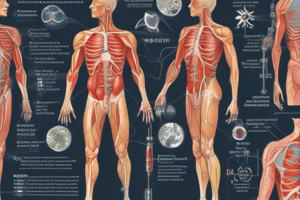Podcast
Questions and Answers
What is the normal pH range for maintaining acid-base balance in the body?
What is the normal pH range for maintaining acid-base balance in the body?
- 7.25-7.35
- 7.50-7.60
- 7.35-7.45 (correct)
- 7.20-7.30
Which component is essential for the synthesis of thyroid hormones?
Which component is essential for the synthesis of thyroid hormones?
- Calcium
- Iron
- Zinc
- Iodine (correct)
What is a characteristic feature of negative feedback in hormonal balance?
What is a characteristic feature of negative feedback in hormonal balance?
- Stimulus amplifies production
- Stimulus reduces its own production (correct)
- Stimulus creates a continuous cycle
- Stimulus has no effect on production
Which hormone formation occurs when Monoiodotyrosine (MIT) and Diiodotyrosine (DIT) combine?
Which hormone formation occurs when Monoiodotyrosine (MIT) and Diiodotyrosine (DIT) combine?
What buffer ratio is considered key for maintaining acid-base balance in the body?
What buffer ratio is considered key for maintaining acid-base balance in the body?
In primary hypothyroidism, what is a likely consequence of impaired T3 and T4 synthesis?
In primary hypothyroidism, what is a likely consequence of impaired T3 and T4 synthesis?
Which of the following best describes how proteins function in acid-base balance?
Which of the following best describes how proteins function in acid-base balance?
What is a potential effect of elevated reverse T3 (rT3) levels?
What is a potential effect of elevated reverse T3 (rT3) levels?
What primary mechanism does hemoglobin serve in relation to acid-base balance?
What primary mechanism does hemoglobin serve in relation to acid-base balance?
Which statement accurately describes the role of bicarbonate in acid-base balance?
Which statement accurately describes the role of bicarbonate in acid-base balance?
In conditions of respiratory acidosis, which physiological change is expected in pCO2 levels?
In conditions of respiratory acidosis, which physiological change is expected in pCO2 levels?
What is the primary function of carrier proteins for hormones in circulation?
What is the primary function of carrier proteins for hormones in circulation?
How does negative feedback influence hormonal balance?
How does negative feedback influence hormonal balance?
What condition is characterized by the presence of anti-TPO antibodies?
What condition is characterized by the presence of anti-TPO antibodies?
Which mechanism describes the process of recycling iodine in the thyroid gland?
Which mechanism describes the process of recycling iodine in the thyroid gland?
Elevated levels of which hormone are indicative of hyperthyroidism and its associated conditions?
Elevated levels of which hormone are indicative of hyperthyroidism and its associated conditions?
Which symptom is primarily associated with severe hypothyroidism in adults?
Which symptom is primarily associated with severe hypothyroidism in adults?
What result occurs when Diiodotyrosine (DIT) molecules combine?
What result occurs when Diiodotyrosine (DIT) molecules combine?
What is the role of hemoglobin in relation to CO2 transport?
What is the role of hemoglobin in relation to CO2 transport?
What is a significant difference between positive and negative feedback mechanisms in the body?
What is a significant difference between positive and negative feedback mechanisms in the body?
Which of the following statements regarding the binding of thyroid hormones is accurate?
Which of the following statements regarding the binding of thyroid hormones is accurate?
Which factor is most likely to contribute to primary hypothyroidism aside from iodine deficiency?
Which factor is most likely to contribute to primary hypothyroidism aside from iodine deficiency?
What role does bicarbonate play in the body's acid-base balance?
What role does bicarbonate play in the body's acid-base balance?
In the metabolic process involving thyroid hormones, what is typically the first step of T4 conversion?
In the metabolic process involving thyroid hormones, what is typically the first step of T4 conversion?
Which statement correctly identifies a common symptom associated with hyperthyroidism?
Which statement correctly identifies a common symptom associated with hyperthyroidism?
How does reverse T3 (rT3) influence the thyroid hormone function during stress or illness?
How does reverse T3 (rT3) influence the thyroid hormone function during stress or illness?
What is a characteristic feature of hemoglobin's function in acid-base balance?
What is a characteristic feature of hemoglobin's function in acid-base balance?
What is the primary reason for elevated Thyroid-Stimulating Hormone (TSH) levels in primary hypothyroidism?
What is the primary reason for elevated Thyroid-Stimulating Hormone (TSH) levels in primary hypothyroidism?
Which statement about reverse T3 (rT3) in thyroid hormone metabolism is accurate?
Which statement about reverse T3 (rT3) in thyroid hormone metabolism is accurate?
In the context of acid-base balance, what is the role of phosphate as a buffer system?
In the context of acid-base balance, what is the role of phosphate as a buffer system?
Which of the following statements accurately describes the storage and release of thyroid hormones?
Which of the following statements accurately describes the storage and release of thyroid hormones?
In which scenario would you expect elevated levels of pCO2 to indicate respiratory acidosis?
In which scenario would you expect elevated levels of pCO2 to indicate respiratory acidosis?
Which of the following conditions is primarily associated with Hashimoto's Thyroiditis?
Which of the following conditions is primarily associated with Hashimoto's Thyroiditis?
What differentiates positive feedback from negative feedback in hormonal regulation?
What differentiates positive feedback from negative feedback in hormonal regulation?
How does the bicarbonate buffer system operate in maintaining acid-base balance?
How does the bicarbonate buffer system operate in maintaining acid-base balance?
What impact does iodine deficiency have on thyroid hormone production?
What impact does iodine deficiency have on thyroid hormone production?
What happens during the physiological responses to an increase in carbon dioxide (CO2) levels?
What happens during the physiological responses to an increase in carbon dioxide (CO2) levels?
Flashcards
Acid-Base Balance
Acid-Base Balance
Maintaining the correct hydrogen ion (H+) concentration in the body, primarily by the lungs and kidneys.
Bicarbonate Buffer System
Bicarbonate Buffer System
A crucial buffer system in the body, with a 20:1 ratio of bicarbonate to carbonic acid, playing a key role in regulating pH.
Normal pH range
Normal pH range
7.35-7.45
Respiratory Acidosis
Respiratory Acidosis
Signup and view all the flashcards
Thyroid Hormones
Thyroid Hormones
Signup and view all the flashcards
Thyroid Hormone Formation
Thyroid Hormone Formation
Signup and view all the flashcards
Negative Feedback Mechanism
Negative Feedback Mechanism
Signup and view all the flashcards
Hypothyroidism
Hypothyroidism
Signup and view all the flashcards
Hashimoto's Thyroiditis
Hashimoto's Thyroiditis
Signup and view all the flashcards
Thyroxine-Binding Globulin (TBG)
Thyroxine-Binding Globulin (TBG)
Signup and view all the flashcards
What is the normal range for blood pH?
What is the normal range for blood pH?
Signup and view all the flashcards
What is the role of the lungs in acid-base balance?
What is the role of the lungs in acid-base balance?
Signup and view all the flashcards
What does 'pCO2' stand for?
What does 'pCO2' stand for?
Signup and view all the flashcards
What is the function of a buffer system in the body?
What is the function of a buffer system in the body?
Signup and view all the flashcards
What is the key buffer system in the body?
What is the key buffer system in the body?
Signup and view all the flashcards
How does Hemoglobin contribute to acid-base balance?
How does Hemoglobin contribute to acid-base balance?
Signup and view all the flashcards
What is the role of the kidneys in acid-base balance?
What is the role of the kidneys in acid-base balance?
Signup and view all the flashcards
What is the difference between negative and positive feedback?
What is the difference between negative and positive feedback?
Signup and view all the flashcards
What is hypothyroidism?
What is hypothyroidism?
Signup and view all the flashcards
What is hyperthyroidism?
What is hyperthyroidism?
Signup and view all the flashcards
What is the normal pH range for blood?
What is the normal pH range for blood?
Signup and view all the flashcards
What are buffer systems?
What are buffer systems?
Signup and view all the flashcards
What is the difference between T3 and T4?
What is the difference between T3 and T4?
Signup and view all the flashcards
How does Thyroid Stimulating Hormone (TSH) work?
How does Thyroid Stimulating Hormone (TSH) work?
Signup and view all the flashcards
pH and Acid-Base Imbalances
pH and Acid-Base Imbalances
Signup and view all the flashcards
Thyroglobulin (Tg)
Thyroglobulin (Tg)
Signup and view all the flashcards
Myxedema
Myxedema
Signup and view all the flashcards
Study Notes
Acid-Base Balance
- Maintenance: Lungs and kidneys maintain hydrogen ion (H+) levels.
- Buffer Systems:
- Bicarbonate: Key buffer, with a 20:1 ratio to carbonic acid.
- Hemoglobin: Transports carbon dioxide (CO2).
- Phosphate: Aids in hydrogen ion (H+) excretion.
- Proteins: Can act as either acids or bases.
- pH:
- Normal Range: 7.35-7.45
- Above 7.45: Alkalosis
- pCO2:
- Normal Range: 35-45 mmHg
- Above 45 mmHg: Respiratory acidosis
Acid-Base Imbalances
Feedback Mechanisms
- Negative Feedback:
- Most common mechanism for hormonal balance.
- Stimulus reduces its own production, maintaining stability.
- Positive Feedback:
- Less common.
- Amplifies a stimulus until a specific endpoint is reached.
Thyroid Gland Overview
- Location: Neck, composed of follicles filled with colloid.
- Key Components:
- Colloid: Contains thyroglobulin (Tg), crucial for thyroid hormone production.
- Iodine: Essential for thyroid hormone synthesis, actively transported into the gland.
Thyroid Hormone Formation
- Thyroglobulin (Tg): Primary protein in thyroid follicles.
- Iodine Binding:
- Tyrosine residues on Tg bind iodine to form:
- Monoiodotyrosine (MIT)
- Diiodotyrosine (DIT)
- Tyrosine residues on Tg bind iodine to form:
- Hormone Formation:
- MIT + DIT = Triiodothyronine (T3)
- DIT + DIT = Thyroxine (T4)
- Release: T3 and T4 are released into the bloodstream upon TSH stimulation.
- Recycling: Enzymes deiodinate MIT and DIT to recover iodine.
Thyroid Hormone Metabolism
- T4 Conversion: Primarily converted to the active form (T3) in the liver.
- Reverse T3 (rT3): Inactive form of T4; increases during stress, illness, or certain medications.
- Binding: T3 and T4 bind to TBG, TBPA, and albumin for controlled release.
Thyroid Disorders
- Hypothyroidism:
- Symptoms: Lethargy, fatigue, cold intolerance, myxedema (adults), cretinism (children).
- Anti-TPO antibody: common
- Primary Hypothyroidism:
- Symptoms: Impaired T3/T4 synthesis, increased TSH levels.
- Causes: Iodine deficiency, Hashimoto's Thyroiditis (autoimmune attack on thyroid tissue).
- Hyperthyroidism (Thyrotoxicosis):
- Symptoms: Low TSH level (opposite of primary hypothyroidism).
Studying That Suits You
Use AI to generate personalized quizzes and flashcards to suit your learning preferences.





